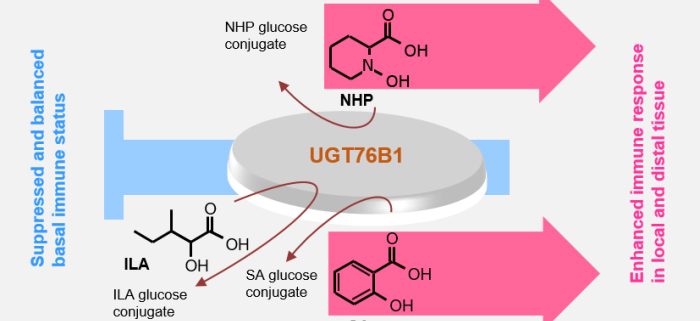Interactive glucose attachment to multiple signaling molecules as an immune-suppressive platform to contain plant pathogen defense
By Dereje W. Mekonnen1, Jürgen Zeier2, Anton R. Schäffner1
1Institute of Biochemical Plant Pathology, Department of Environmental Sciences, Helmholtz Zentrum München, München, Germany
2Institute for Molecular Ecophysiology of Plants, Department of Biology, Heinrich-Heine-Universität Düsseldorf, Düsseldorf, Germany
Background: Plants use different strategies to defend themselves against pathogens. In addition to local defense at the site of infection, distal parts of the plant are alerted enabling efficient defense in case of further attacks. Salicylic acid (SA) controls these responses in concert with other small molecules like N-hydroxypipecolic acid (NHP) and isoleucic acid (ILA). Suppressive mechanisms counterbalance this costly immune response in naïve, non-infected plants. One important reaction is catalyzed by glucosyltransferases, which generally render small signaling molecules inactive by attaching a glucose moiety. UGT76B1 is a glucosyltransferase of the model plant Arabidopsis known to attach glucose to SA and ILA, thereby attenuating defense responses. Previous evidence indicated that UGT76B1 is also activated in conjunction with the biosynthesis of NHP.
Question: Therefore, we aimed at exploring an additional role of UGT76B1 in relation to the signaling molecule NHP. To test this potential interaction, we studied mutants that abolished the UGT76B1 function along with the biosynthesis of SA or NHP in response to pathogen infection and exogenous application of signaling molecules.
Findings: Metabolic analyses and biochemical studies revealed that UGT76B1 also forms an NHP glucose conjugate in addition to SA and ILA glucosylation. Thus, UGT76B1 provides a common platform to contain the levels of all three signals in an interactive and competitive manner, which establishes the suppressed defense status of naïve plants and enables a dynamic control of the response upon pathogen infection. The loss of functional UGT76B1 releases this control and leads to an activated NHP- and SA-dependent state of defense in the absence of any pathogen infestation, which resembles the alerted immune status in distal tissues in response to a local incident. In contrast, the experimental, constitutive expression of UGT76B1 reduces the active NHP and SA pools and eliminates the capability of both local and distal defense.
Next steps: The functional interaction among SA, NHP, and ILA through a common glucosylation platform should be extended to their biosynthesis and mobility. It will be also interesting to explore this regulatory node in other plant species. Furthermore, the formation and function of a second type of UGT76B1-independent glucose attachment to NHP is not resolved.
Sibylle Bauer, Dereje W. Mekonnen, Michael Hartmann, Ipek Yildiz, Robert Janowski, Birgit Lange, Birgit Geist, Jürgen Zeier, Anton R. Schäffner. (2021) UGT76B1, a promiscuous hub of small molecule-based immune signaling, glucosylates N-hydroxypipecolic acid and balances plant immunity. Plant Cell. https://doi.org/10.1093/plcell/koaa044




